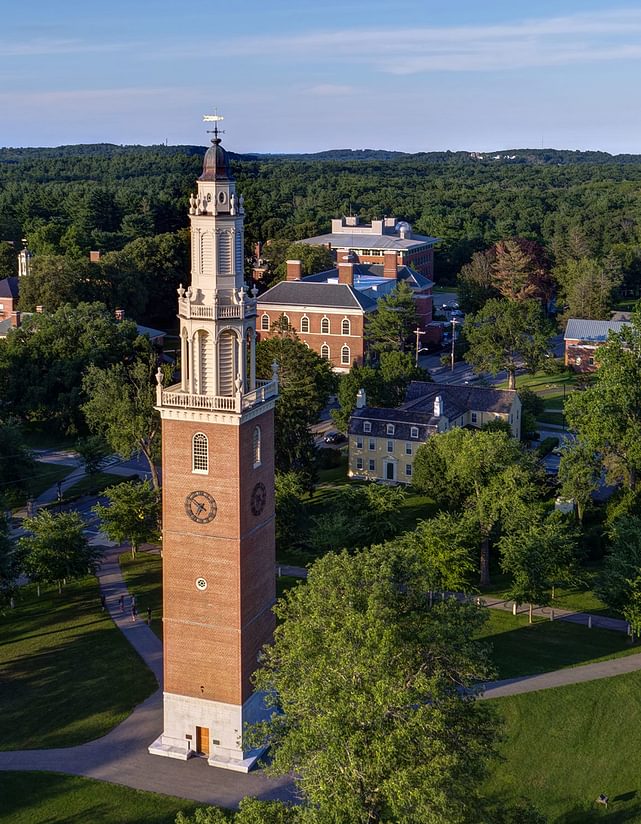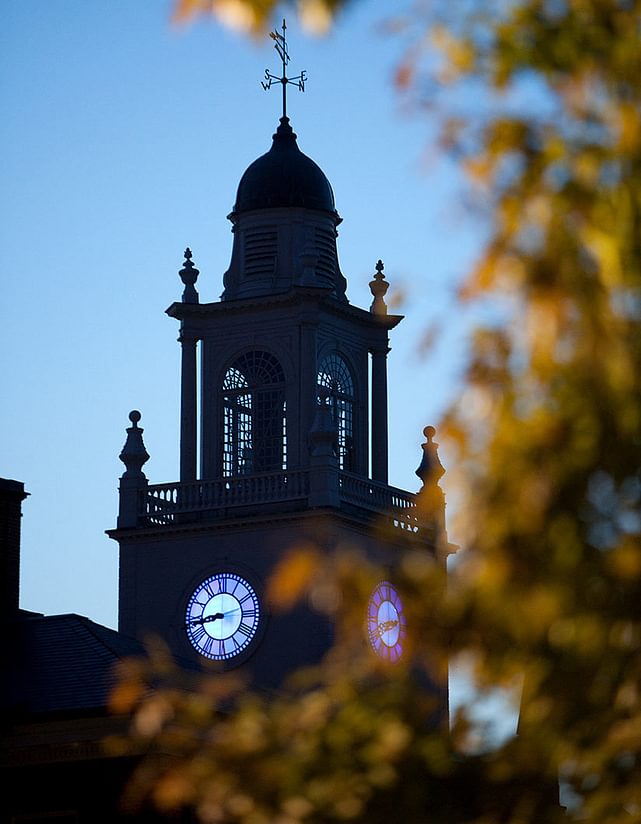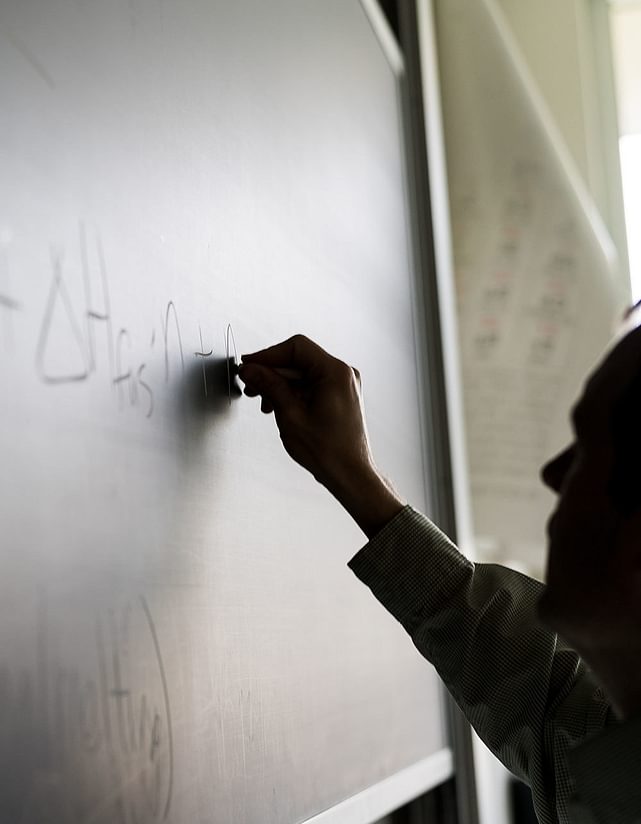Reflections
Send us 50 words for 50 years. We're looking to capture diverse and myriad experiences from the community after the Academy went coeducational. Email us with your reflection. Please note that we will not publish any reflections without permission.
Jasmine Mitchell ’99
When I opened the most recent issue of Andover magazine, I saw the article commemorating 50 years of Andover coeducation, which included a piece about my own personal story along with the way that alumni use their Andover education to break stereotypes and guide others who have been historically excluded from spaces to claim their places. With Andover and Abbot Academy as a singular institution, I am so proud to be among these pathbreaking alums ushering in social change.
Coming back to campus this past September for Alumni Council Weekend, I was inspired by students, faculty, staff, and alumni who are taking on the mantle of boldness, innovation, and caring.
Cmdr. Catherine A.B. Reppert ’02, U.S. Navy
On this 50th anniversary of the merging of Phillips and Abbot, it is important for me to acknowledge my feeling that had something to prove as a woman entering the Naval Academy 20 years ago. While the ethos of doing hard things has stuck with me, the feeling of having to prove myself is gone. For this, I must thank the many awesome and trailblazing women who came before me and the many women currently serving in the Armed Forces.
As my last operational assignment, I had the honor to command an all-male warship, and I never once felt less than or that I had anything to prove as a woman. I felt competent, with good training and ample preparedness to do my job—and that competence bred confidence. That confidence garnered trust in our team’s ability to do all sorts of hard things.
I am grateful to serve in an era in which I am judged by my competence to lead a warship at sea, not my appearance or gender.
Tamara Elliott Rogers ’70
This is a special time in the life of Andover—it is the 50th anniversary of the merger of Abbot Academy and Phillips Academy to become a single, and I would say singular, school. So, I looked back at my old Andover magazine from the time of the 40th anniversary, and the cover read: “Coed at 40: Then and Now.” This summer’s 50th anniversary magazine cover reads: “Abbot and Andover at 50: Then, Now, Next,” expressly invoking the future.
I began at Abbot as an 11th-grade day student in 1968. All my previous schooling had been in the public schools of Lowell, where I learned a great deal, but classes were massively crowded (mid–baby boom) and expectations for girls were, shall we say, somewhat narrower than they are now. And while 1968 was also a pretty fraught time politically—not unlike now—Abbot was the most consequential turning point of my life.
Small classes, an expectation that we would go to college, teachers who were responsive to my endless requests for more reading, a campus so beautiful that I thought I was in a book, not a real place. And two women in particular—Miss St. Pierre and Mrs. Finbury—who each in her own way nurtured and pushed me, setting aspirations I would never have imagined for myself. My many volunteer roles at Andover are a deeply rewarding way of repaying the debt that can never, ever be repaid.
Abbot lives on in many ways. Through spaces, including the Timken Room in Graves Hall; the Brace Center for Gender Studies; the recently dedicated Chandler-Wormley Vista, in recognition of Abbot’s first two Black graduates from the Class of 1955; the Kate Frisken Practice Room; the Abbot Academy Dance Studio, named in honor of Cristina Rubio (La Señora, to those of us who studied dance under her); and the Jean St. Pierre Outdoor Classroom near Bulfinch.
And Abbot lives on through the alumnae who preserve the Abbot legacy and advance Andover as well, through serving on the Alumni Council, Abbot Alumnae Engagement Initiative, Abbot Academy Fund, and as class secretaries and class agents.
The Andover campus (inclusive of Abbot’s now beautifully preserved campus) is now abuzz with wonderful students from so many backgrounds and locations, engaging in an exceptional, broadly gauged educational experience. I especially love it when we as trustees meet with students—they are inspiring even (or perhaps especially!) when they take us a bit to task for our retrograde selves.
Then, now, next. Andover’s head of school, Raynard Kington, believes in understanding history; he is dedicated to providing the best possible education and experience for our students and is committed to meeting the future head-on, with energy. All of this informs his leadership of our Academy. And I proudly say “our”—all of us.
The Rev. Gina M. Finocchiaro ’97
Being a member of the Andover community right now is both a privilege and an honor, though it requires endurance, energy, and vision. I believe the school is at a point of inflection. We are examining and revising policies. We are considering curriculum competencies and goals, and we are charting a course for the next chapter of our history. It is a time of rebuilding and innovation and clarity.
Abbot and Phillips had merged years before I arrived at Andover as a student. I came to know of the impactful and deep legacy of Abbot Academy through matriarchs like Jean St. Pierre and Sue Lloyd— though my connection and knowing of Jean was much stronger. Jean’s love of Abbot helped me to understand and know the history of education for girls and women, and the tensions that students and faculty endured as the merger of the two schools unfolded. Her stories were the beginning of an awakening for me, in so many ways. I became curious about single-sex education, and I believe that my decision to attend a seven sisters’ college grew from some of that influence. It was in college that I gained a fuller picture of women’s history and rights, as I was coming into my own voice and vocation.
Over the years since my graduation, I have met numerous Abbot alumnae who speak passionately about their years on campus as a place where they were challenged, nurtured, uncomfortable, and held. They carry a love for Abbot that mirrors my own appreciation of my alma mater, a women’s college, which feels distinctly different than the ways I hear alumni/ae talk about their school post-merger.
Returning to Andover as a member faculty, I have new and widening appreciation for the legacy of Abbot. There are, of course, elements that are tangible—the Brace Center is an extraordinary gift. A stand-alone of our peer institutions, it has made space for exploration and study, for leading the way in gender inclusivity and fluidity. The Abbot Academy Fund has fueled students and faculty alike in creativity for new endeavors, that keeps the possibility for change always present.
Perhaps the most meaningful and lasting impact that Abbot has had at Andover is one of accountability. I can still hear Jean in my ear bemoaning the inequities of access for girls when Abbot first came up the hill, and perhaps those stories have planted in me a perspective that I cannot shake. The merger of schools meant that Andover, as a whole, made a commitment to all students. Abbot alumnae and faculty lobbied tirelessly to be seen, to be heard, to have spaces that welcomed them and spaces of their own. This advocacy, in some ways, set the framework for how this new school would continue to adapt and be challenged and made finer by the ever-changing needs of its students. Anyone who thought Abbot would slowly disappear into history, has been fiercely wrong.
The work of accountability at an institution like Phillips Academy is of great importance. It means constantly reminding the school—its leaders, faculty, students and alumni/ae alike—of the tenets that we hold at the center: knowledge and goodness, youth from every quarter, non sibi (not for self).
In my myriad of roles at Andover, I try to stay centered in those core values and to teach, lead, and speak from them. When I waiver, at times, I see in my mind’s eye those small Abbot-blue buttons that say, “Save Abbot,” and I am encouraged as I stand on the shoulders of those who have come before me, especially the women.
Looking ahead, Andover has made a commitment to becoming an anti-racist community. This charge will take work of the heart, mind, and hand to come to fruition. It will mean that we need to interrogate our long-held beliefs, biases, and responses and ask new questions of ourselves and the institution. It asks that we see individuals wholly and fully for who they are, in the complexities of their identities and experiences. There are echoes in this work of the merger that also required Phillips to reconsider once-held norms to welcome Abbot and become something new.
I learned some years ago, from a novelist whose name I no longer remember, that the work of a good leader is not to meet people where they are, or to bring them to the place where you are, but instead to travel with them to arrive together in some new, yet unknown place that will be the future.
Rev. Gina Finocchiaro is ordained in the United Church of Christ and is deeply involved in social justice issues. She currently serves as the Protestant Chaplain, lives on campus in a girls’ dorm, and teaches in the Empathy, Balance & Inclusion curriculum.
It was a pivotal moment. With issues of diversity and inclusion, the school had taken its first step with coeducation.
”Alexandra Morrow ’12
When the Abbot Academy Fund approached me in August 2022 to produce a film showcasing their first 50 years I was thrilled, not only for the opportunity to learn about the fund’s history, but also to gain insight into the emotional landscape through which it was born. To have an opportunity to sit in conversation with those who lived through the merger and listen to the ways the transition changed the trajectory of Phillips Academy was a great responsibility—and one I did not take lightly.
What I had not anticipated, however, was how the spirit of Abbot would imbue itself into the making of the film. Through the process of filming more than 25 interviews over eight months, our team was moved again and again by the love that alumnae hold for Abbot Academy, and an awareness of how transformative the school had been for them. The stories that were shared fostered an environment of caring among our whole team, as well as an appreciation for the trustees who had the foresight to ensure that Abbot’s legacy would continue.
The process of creating this film has illuminated the reality that Abbot’s legacy does live on. It lives on through AAF-funded projects like Non Sibi Day, Andover Bread Loaf, the Abbot Academy Dance Suite, mental health awareness and support, and student-led clubs that offer a sense of home and belonging. The Abbot Academy Fund has done much more than put names on buildings, it’s made people feel seen and shifted the entire culture of a school.
In any filmmaking project there are lessons to be learned about how to exist as an emotional being in this world. As I reflect on the making of this film, I’m left with an awareness of what it means to profoundly love something.
As mortal beings in a mortal world, there is this universal hope that what we love will live on, that letting go doesn’t have to mean forgetting, and that with change there can also come new beginnings. The new beginning created by the merger between Abbot Academy and Phillips Academy fostered an environment that continues to benefit many. When I think back to my time at Phillips Academy and all the ways it transformed me, I see now that Abbot was there too—weaving its spirit through campus in many ways—as it will be for years to come.
Alexandra Morrow ‘12 is a Vermont-based filmmaker and founder of Armadillo Collective, a production company that partners with purpose-driven humans who view film as a tool to amplify stories and strengthen community. You can learn more about her work at armadillocollective.com.
Don Gordon was the antithesis of authoritarian, the antithesis of rigid. He’d see problematic situations and listen and try his best to work through it. He took the job to lead Abbot, but I think even he was surprised by just how much he fell in love with the school. He fought hard to do right by Abbot.
”Andrew Housiaux, Currie Family Director, Tang Institute
When I think of Abbot Academy, one of the most important things that comes to mind for me is a deep dedication to student learning and to innovative approaches to teaching. The Abbot teachers sought to challenge their students in important and new ways, and my hope is that this spirit of pedagogical innovation and inspiration shines through the Tang Institute as well.
At the Tang, we support projects that help teachers create inclusive learning environments where all students feel a sense of belonging. This past year, we supported research done by ACE (Andover: Challenge & Empower) Director Latasha Boyd, who studied ways in which to increase a sense of belonging among these students who are new to Andover. Her findings have been shared with her research cohort and their conclusions have already impacted the student experience here and at other schools. By bringing Latasha and other Andover educators into conversation with a cohort of educators at other schools focused on questions of transitions and belonging, the Tang Institute helped to support an inclusive learning environment on campus and at a range of other schools.
Partnerships and collaborations like the one described above enable Andover to learn from and positively impact a range of schools. Looking ahead, I am hopeful that we will continue to deepen these partnerships and think collaboratively with a range of schools, universities, think tanks, and other research organizations about the tremendous challenges facing us as humans, most notably the rise of AI and ongoing climate chaos.
The impact of being part of a smart, interesting and quirky community of women (like me) who not only understood but celebrated me for just being myself was huge!
”Tamika Guishard ’98
Traditional West African drum and dance drives my award-winning, feature-length screenplay about a triad of youth (whose Shero’s a PA alumna) aged out of a broken foster care system. These age-old rhythms powerfully and purposefully emboldened Indigenous communities for centuries. Although African dance is not standardly offered within Andover’s curriculum, dancing on campus—particularly as a founding member of S.L.A.M.—endowed me with power, purpose, and community throughout my four years.
When Señora Cristina A. Rubio persuaded the athletics department to seriously consider dance upon her transition to PA from Abbot, I wonder if she knew how it would impart a sense of belonging for Black and Brown girls like me in “Andover-land.” Fresh from my hometown step team in East New York, I taught the library of steps that I had inherited to newly minted S.L.A.M.’rs in West Quad dorm basements, where we cultivated #blackgirlmagic before hashtags, cell phones, and cyberspace were household names. A thirteen-year-old navigating identity politics, raging hormones, and the humility that comes with realizing that you are no longer the smartest in your class, I soaked up this fellowship—ironically named “Spirit Leaders of Andover Madness”—which kept me from going mad.
The brainchild of Ashanti Hosier ’95 and Angela Brown ’96 that synthesized cheerleading (with European origins) and stepping (steeply rooted in African-American culture), S.L.A.M. also worked to underpin the African diaspora on campus. I will never forget the smile that washed over Dr. Temba Maqubela’s face [former dean of faculty] as our rhythmic practice in Nathan Hale transported him to his native South Africa where he was brought up doing gumboot dance. He, in turn, taught us the calls and movements that miners had originated to communicate when silenced while working. Needless to say, we were thrilled to show off our learnings at the annual Coffee House Night while continuing to perfect our craft of “slamming” at Grasshopper Night during my junior year.
A lifelong friend of mine and former school leader always says that “women should write history and men should write fiction,” because the latter generally focuses on outcomes—wins and losses. Meanwhile the former tends to be more concerned with the in-between: how did folks make out during the conflict? Feed their kids? Maintain their sanity? Perhaps Ms. Rubio could sense that dance at Andover would one day ignite diasporic connections between this West Indian Brooklynite, continental Africans, and descendants of Black Americans in our small corner of New England. In assessing the variance amongst student backgrounds, maybe she knew that universally accessible and affordable activities like dance would be just the thing to ensure that no matter who they are or where they come from, Andover learners could feel at home.
Today we can point to scientific data validating dance’s holistic benefits for mind, body, and spirit, but back in 1973, Ms. Rubio just went with her gut and I, for one, am forever grateful for herstory.
Tamika Guishard is a first-generation Brooklynite with African and Kittitian roots. With the mind of a (park) ranger, heart of a teacher, and soul of a dancer, she has come to the forefront as an award-winning filmmaker, providing a platform to amplify marginalized voices.
Years after coeducation, also years after women’s liberation and the assertion of women’s legitimacy in our society, students’ respect, pride, and appreciation for the Abbot legacy holds stronger than ever.
”Ann Goodwin ’75
I am so interested in the summer magazine’s coverage of the merger in 1973. Thank you for featuring it.
I was in that first group of girls, entering in 1973 as an 11th-grade student for the first two years of coeducation. It was indeed a complicated time to be there, and I realize now how oblivious I was about what came before our arrival. For example, I had no idea how many of the girls in my class had attended Abbot, or how many, like me, were totally new to the school. I also had never before considered that some Abbot girls felt intimidated by the “new” girls. I felt at the time that the merger was easier for the Abbot girls, especially socially, which just underscores how blind we can be to the challenges faced by others.
It is fascinating, all these years later, to revisit that time with the context that this article, and other magazine articles about Abbot, have provided.



